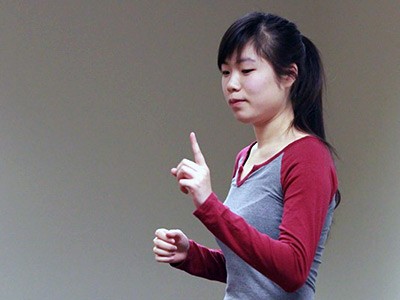American Sign Language Programs Growing
ASL classes at USU are an immersion experience. Students sign without using their voices.
A recent report by the Modern Language Association reveals declining enrollments in foreign languages on college campuses. But there’s a bright spot on the language landscape: American Sign Language (ASL).
Aggregate foreign language enrollments decreased by 6.7 percent since 2009, but American Sign Language was up 19 percent over four years.
That trend is reflected at Utah State University. In recent years, the Communicative Disorders and Deaf Education Department added two minors in ASL, one in ASL as a foreign language and the other as a teaching minor.
Those who want to teach Deaf students using ASL are required to complete a master’s degree in Deaf Education.
But most of the students attending ASL classes at USU — and there are 500 of them — are satisfying a foreign language requirement. There are currently waiting lists for ASL.
Some students have personal reasons for learning the language.
“My three-year-old niece is Deaf, and I want to be able to talk to her,” said Anna Lantis, a junior in elementary education at USU who is enrolled in an ASL class. “I always thought sign language is a beautiful language.”
Bethany King, another education major, said she’s studying ASL because she wants to communicate with all students who enter her future classroom — and to do it proficiently. She also enjoys the language.
“I love how expressive it is and how it’s able to convey so much information,” she said.
“It’s a novel language in that it’s a visual language, and that seems to attract students,” said Freeman King, a professor and the Deaf Education division chair at USU. (Bethany is his daughter — and it’s no surprise that she came forward to talk about a language and culture that she has enjoyed through her growing-up years.)
Freeman King hopes that more area schools will follow the national trend and open up ASL classes. Doing so could start a two-way relationship between high schools and the university. Some students receiving ASL exposure in high school, while USU practicum students and certified teachers would have greater opportunities to teach.
Currently there are ASL high school classes being offered in Ogden, Salt Lake City, Provo and numerous other Utah high schools, as well as USU, Utah Valley University, Dixie and BYU.
But it’s essential that ASL programs offer quality instruction, said Curt Radford, a faculty member who teaches ASL.
“We get a few students who have learned ASL in high school,” he said. “A few of them have an advantage, depending on the quality of the instruction and how many years they have taken it. But some students are at a disadvantage if they did not learn ASL appropriately, because it is difficult to overcome bad habits.”
Radford, who is also profoundly Deaf, remembers his own classroom experience, watching teachers converse fluently in spoken English while using only basic sign language with him. He had to play a lot of catch-up later on, he said.
USU graduates who expect to teach ASL as a second language are required to pass the American Sign Language Teachers Association’s certification requirements.
In addition, future teachers in the Deaf Education Teacher Training program gain more than 700 hours of practicum experience.
Becoming proficient in ASL offers benefits to those who learn its nuances, slang and culture, Radford said. “Languages are languages. If you learn ASL, you’re going to understand English better.”
For more information on ASL programs at USU, contact Michelle Wilson, the Deaf Education advisor. Her email is below.
Related links:
USU Communicative Disorders and Deaf Education Department
USU’s Emma Eccles Jones College of Education and Human Services
Contact: Michelle Wilson, michelle.wilson@usu.edu
Writer: JoLynne Lyon, 435-797-1463
Comments and questions regarding this article may be directed to the contact person listed on this page.






